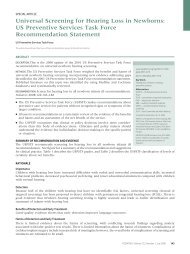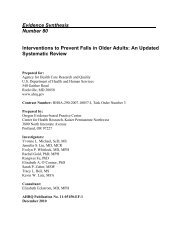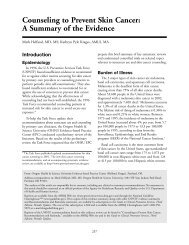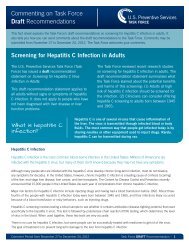Screening for Depression in Adult Patients in Primary Care Settings ...
Screening for Depression in Adult Patients in Primary Care Settings ...
Screening for Depression in Adult Patients in Primary Care Settings ...
You also want an ePaper? Increase the reach of your titles
YUMPU automatically turns print PDFs into web optimized ePapers that Google loves.
Cl<strong>in</strong>ical Guidel<strong>in</strong>es <strong>Primary</strong> <strong>Care</strong> <strong>Screen<strong>in</strong>g</strong> <strong>for</strong> <strong>Depression</strong> <strong>in</strong> <strong>Adult</strong>s<br />
patients (88% to 95%) tolerated these medications, although<br />
adverse side effects and overall discont<strong>in</strong>uation<br />
rates were higher <strong>in</strong> older adults (44–51). Large populationbased<br />
observational studies suggest that upper gastro<strong>in</strong>test<strong>in</strong>al<br />
bleed<strong>in</strong>g is a concern <strong>for</strong> older adults, particularly<br />
when antidepressants are comb<strong>in</strong>ed with nonsteroidal anti<strong>in</strong>flammatory<br />
drugs (NSAIDs).<br />
Completed Suicide<br />
None of the 7 meta-analyses supplied clear evidence<br />
that use of second-generation antidepressants (or SSRIs <strong>in</strong><br />
particular) <strong>in</strong>creased odds of completed suicide <strong>in</strong> adults of<br />
any age compared with placebo. However, power to detect<br />
these rare events was limited, given very few suicides (7 to<br />
43 total suicides among all patients per review). In most<br />
meta-analyses, pooled rates of suicide ranged from 3.8 to<br />
8.8 per 10 000 adults who received antidepressants compared<br />
with 2.3 to 9.3 per 10 000 patients who received<br />
placebo. The 2 meta-analyses that represented outliers were<br />
probably because of methodological differences <strong>in</strong> metaanalysis<br />
design (16). A report by the U.S. Food and Drug<br />
Adm<strong>in</strong>istration estimated many fewer suicides than other<br />
reviews and used a hierarchical outcome assignment<br />
method adm<strong>in</strong>istered by trial sponsors, which may have<br />
underascerta<strong>in</strong>ed suicides (34, 35). The much higher estimates<br />
of suicide rates <strong>in</strong> patients who received antidepressants<br />
and placebo <strong>in</strong> another review (37) could reflect the<br />
greater disease severity among studied patients. In addition,<br />
there were several quality concerns about this review,<br />
which <strong>in</strong>clude unclear event classification schema and lack<br />
of quality appraisal.<br />
To complement short-term data from trials, we exam<strong>in</strong>ed<br />
3 fair- or good-quality large observational studies that<br />
reported suicide with antidepressant treatment <strong>in</strong> a total of<br />
383 796 patients <strong>in</strong> a large HMO <strong>in</strong> the United States and<br />
<strong>in</strong> general practices <strong>in</strong> the United K<strong>in</strong>gdom (52–54) (Appendix<br />
Table 6, available at www.annals.org). Among the<br />
2 highest-quality studies, crude suicide rates were 4.7 and<br />
4.8 per 10 000 persons after 6 to 8 months of receiv<strong>in</strong>g<br />
treatment primarily with second-generation antidepressants,<br />
with slightly higher rates reported among those<br />
younger than 30 years. These studies also <strong>in</strong>dicated higher<br />
risk <strong>for</strong> suicide among men compared with women. Although<br />
these observational studies do not provide comparative<br />
<strong>in</strong><strong>for</strong>mation <strong>for</strong> persons who were not receiv<strong>in</strong>g antidepressants,<br />
they give credence to the estimate of<br />
approximately 4 per 10 000 suicide cases among patients<br />
who received antidepressants, which was found most consistently<br />
<strong>in</strong> the meta-analyses of short-term trial data.<br />
Suicidal Behaviors<br />
Suicidal behaviors were def<strong>in</strong>ed differently across studies<br />
but usually <strong>in</strong>cluded suicide attempts, preparatory acts,<br />
or serious self-harm. Results from 5 meta-analyses that reported<br />
9 separate pooled estimates showed no statistically<br />
significant differences <strong>in</strong> the odds of suicidal behaviors <strong>in</strong><br />
adults who received treatment with antidepressants com-<br />
pared with placebo, with several exceptions. In 1 fairquality<br />
systematic review, odds of suicidal behaviors were<br />
<strong>in</strong>creased <strong>in</strong> adults of all ages who were treated with SSRIs<br />
<strong>for</strong> any <strong>in</strong>dication (odds ratio [OR], 2.70 [CI, 1.22 to<br />
6.97]) (42); this report was limited to published studies<br />
only and did not have clear adverse event ascerta<strong>in</strong>ment <strong>for</strong><br />
most patients. In a review of regulatory data of placebocontrolled<br />
trials by the U.S. Food and Drug Adm<strong>in</strong>istration,<br />
odds of suicidal behavior were approximately doubled<br />
<strong>in</strong> adults younger than 25 years who received secondgeneration<br />
antidepressants <strong>for</strong> all psychiatric disorders<br />
(OR, 2.31 [CI, 1.02 to 5.64]) (34). In contrast, the odds of<br />
suicidal behaviors were unchanged among middle-aged<br />
adults and were greatly reduced <strong>in</strong> older adults receiv<strong>in</strong>g<br />
second-generation antidepressants (OR, 0.06 [CI, 0.01 to<br />
0.58]) (35).<br />
The highest odds of nonfatal suicidal behavior were<br />
reported <strong>in</strong> adults of all ages who received treatment <strong>for</strong><br />
MDD with paroxet<strong>in</strong>e compared with placebo (OR, 6.70<br />
[CI, 1.1 to 149.4]). The <strong>in</strong>creased risk is assumed to be<br />
primarily <strong>in</strong> young adults because most events (8 of 11)<br />
occurred <strong>in</strong> those aged 18 to 29 years. This good-quality<br />
review conducted by the manufacturer used <strong>in</strong>dependent,<br />
adverse event assignment by experts.<br />
Two good-quality observational studies suggested that,<br />
<strong>in</strong> contrast to a higher risk <strong>for</strong> suicide <strong>in</strong> men, there were<br />
no sex-based differences <strong>in</strong> risks <strong>for</strong> self-harm, but there<br />
were age-related differences (53, 54). Suicide attempts were<br />
greater <strong>in</strong> younger persons (31.4 per 10 000 person-years<br />
<strong>in</strong> those younger than 18 years vs. 7.8 per 10 000 personyears<br />
<strong>for</strong> those 18 years or older) (54) and rates of selfharm<br />
were higher <strong>in</strong> those aged 19 to 30 years (214.7 per<br />
10 000 person-years) than those older than 30 years (88.3<br />
per 10 000 person-years) (53). For all ages, the highest risk<br />
<strong>for</strong> suicidal behaviors occurred dur<strong>in</strong>g the month be<strong>for</strong>e<br />
treatment <strong>in</strong>itiation and the first month of treatment (54).<br />
Rates of suicidal behaviors <strong>in</strong> real-world practice situations<br />
were similar to trial rates <strong>for</strong> 1 study (54) but were substantially<br />
higher <strong>in</strong> the other (53); this higher rate could<br />
reflect real differences or may represent study differences<br />
<strong>in</strong> def<strong>in</strong>itions (and perhaps ascerta<strong>in</strong>ment).<br />
Suicidal Ideation<br />
Three meta-analyses used a comb<strong>in</strong>ed end po<strong>in</strong>t of<br />
suicidal ideation or behavior (34, 38, 41). They found no<br />
differences between patients who received treatment with<br />
antidepressants or placebo, except <strong>for</strong> a reduction <strong>in</strong> older<br />
adults who received treatment with second-generation antidepressants<br />
<strong>for</strong> all psychiatric conditions (OR, 0.39 [CI,<br />
0.18 to 0.78]) (34).<br />
Serious Psychiatric Events<br />
We found no exist<strong>in</strong>g systematic reviews that addressed<br />
serious psychiatric events, such as psychiatric hospitalization<br />
or precipitation of mania. Observational data<br />
did not provide reliable estimates of the effect of antidepressant<br />
use on these outcomes.<br />
798 1 December 2009 Annals of Internal Medic<strong>in</strong>e Volume 151 • Number 11 www.annals.org









